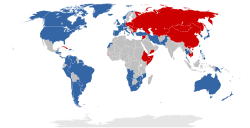Third World: Difference between revisions
| Line 48: | Line 48: | ||
==External links== |
==External links== |
||
* [http://www.aidle.org Search engine where you can save lives] |
* [http://www.aidle.org Search engine where you can save lives] |
||
* [http://video.google.com/videoplay?docid=2670820702819322251 Hans Rosling at TED 2006] |
|||
==References== |
==References== |
||
Revision as of 00:38, 26 December 2007
This article has multiple issues. Please help improve it or discuss these issues on the talk page. (Learn how and when to remove these template messages)
No issues specified. Please specify issues, or remove this template. |
The Third World is a term used, along with First World and Second World, to broadly categorise the nations of the Earth to three social, political, and economic divisions. It is also known in some academic contexts as the Global South.
Origin of the term

The economist and demographer Alfred Sauvy, in an article published in the French magazine L'Observateur, August 14 1952, coined the term Third World in referring to countries currently called either "developing" or "under-developed", especially in Latin America, Africa, Oceania, and Asia, that were unaligned with either the Communist Soviet bloc or the Capitalist NATO bloc during the Cold War (1945–1989).[1] Today, Third World is synonymous with all countries in the developing world, regardless of their political status[citation needed].
Third World was a reference to the Tiers État, the (Third Estate), the commoners of France before and during the French Revolution — opposed to the priests and nobles who composed the First Estate and the Second Estate. Like the third estate, wrote Sauvy, the Third World has nothing, and "wants to be something", implying that the Third World is exploited (as was the third estate) and that its destiny is revolutionary. Moreover, it conveyed the second concept of political non-alignment with neither the industrialised Capitalist bloc nor the industrialised Communist bloc.
The problematic definition of "The Third World"
In academic circles, the countries of the Third World are known as the "Global South", the "developing countries", and the "under-developed countries"; and are called, by economic development workers, the "Two-thirds World" and "The South". Some developers disapprove of the "developing countries" term, because it implies that industrialization is the only progressive way.
History of Third World countries
The economically under-developed countries of Africa, Asia, Americas, and Oceania considered as an entity with common characteristics, such as poverty, uncontrolled high birthrates, and economic dependence upon the advanced countries tended to be former European colonies.
After World War II, the capitalist Western and the communist Eastern blocs fought to expand their spheres of influence to the Third World. The military and intelligence services of the U.S. and the U.S.S.R. worked secretly and publicly to influence Third World governments, with relative success.
The term Third World became popular usage during the Cold War when many poor nations adopted it in describing themselves as aligned with neither N.A.T.O. nor the U.S.S.R., but instead composed an unaligned Third World. In that context, the First World denoted the U.S. and its anti-Communist allies, concomitantly, Second World denoted the "Eastern Bloc" — the U.S.S.R. and its communist and socialist allies.
Originally, the Third World bloc comprised the countries of Yugoslavia, India, and Egypt. Many believed they could successfully court the Communist and Capitalist blocs into economic partnerships without directly falling into the respective sphere of influence. Fearing they would align with the enemy bloc, they were exploited and undermined by the First World and Second World superpowers.
The Third World's economies are distorted by dependence upon exportation of primary products, to the First and Second worlds, in return for finished products. After liberation from colonial rule in the 1950s - 1970s, many Third World nations were illiterate, over-populated, and politically unstable. This was particularly true of Africa, where nation-states were artificially created by European colonial powers in order to control populations by imposing local, minority-rule governments, indifferent to local social and cultural reality.
For the most part, Third World did not include China. Politically, the Third World emerged at the Bandung Conference (1955), which established the Nonaligned Movement. Numerically, the Third World dominates the United Nations, but is so culturally and economically diverse that its political cohesion is hypothetical. The petroleum-rich countries (Saudi Arabia, Kuwait, United Arab Emirates, etc.) and the new industrial countries (India, Malaysia, Brazil, etc.) have little in common with poor countries (Haiti, Chad, Afghanistan, etc.).
Criticism of the term
The term Third World remains in common usage despite criticism that it is inaccurate[citation needed], outdated[citation needed], colonialist[citation needed], and a type of Other category[citation needed]; more because it is an ideology rather than a reality. [2].
In general, Third World countries are not as industrialized or technologically advanced as OECD countries, and consequently developing nation is the current term in use in academia. Terms such as Global South, developing countries, less economically developed countries (LEDC), least developed countries, and the Majority World have become more popular in circles where the term third world is regarded to have derogatory or out-of-date connotations. Other synonymous terms include the two-thirds world (because two-thirds of the world is underdeveloped) and The South. Some theorists, such as Andre Gunder Frank and Walter Rodney have used the term underdevelopment or underdeveloped world, to indicate the active process by which the global South has been locked out of development by imperialism and the post-colonial policies of the richer nations.
See also
External links
References
- ^ Michael Quinion (2005-02-26). "FIRST, SECOND, AND THIRD WORLDS" (html). World Wide Words. Retrieved 2007-07-19.
{{cite web}}: Check date values in:|date=(help) - ^ "Hannah Arendt quotes" (html). ThinkExist.com. Retrieved 2007-07-19.
The Third World is not a reality, but an ideology.
- A. R. Kasdan, The Third World: A New Focus for Development (1973)
- E. Hermassi, The Third World Reassessed (1980)
- H. A. Reitsma and J. M. Kleinpenning, The Third World in Perspective (1985)
- J. Cole, Development and Underdevelopment (1987).
